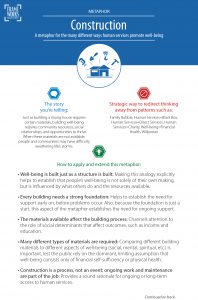Using the Right Metaphor Matters
August 4, 2016In a recent newsletter, we identified communication tips from FrameWorks Institute that can help the human service sector make the most of the new narrative. In addition to using the new frame, there are also words that we know are unproductive and can often invoke those cultural models the research shows undermine our best intentions. Recently, we called attention to the problems with using the word charity.
In this newsletter, let’s look at two fairly ubiquitous metaphors used in sector communications: Safety Net and Journeys. Both work to feed the old narrative that human services benefit the individuals served, rather than society as a whole.
- The Safety Net. While the “safety net” metaphor is something that we have been using for decades to describe the work of human services, FrameWorks cautions against it for a couple of reasons. First, it promotes a limited understanding of human services as basic, temporary aid for people in dire circumstances. The sector’s broader contributions, including prevention, research, and advocacy, are not reflected in this definition. Second, the public now has partisan associations with the term “safety net,” which can shut down conversations by invoking a “politics as usual” mindset.
- Journeys. Metaphors that refer to helping people on their journey, such as “getting people on the road to success” or “climbing the ladder out of poverty” are also common in human services communications. These metaphors emphasize individual choices and actions, obscuring the role that communities, policymakers, programs, and other institutions must also take to improve well-being.
Instead, using Construction Metaphors as part of the Building Well-Being Narrative helps the public understand the full story and benefits of the human service sector. People intuitively understand that construction projects require a range of experts and resources, which inoculates against beliefs that well-being is entirely dictated by individual choices. People also understand that constructing buildings requires thoughtful planning, expertise and know-how, quality tools and materials, and ongoing maintenance and repairs. This helps the public to see human services as a sector of trained professionals who are addressing key societal challenges through a range of strategies, including prevention, research, and advocacy.
Our partners at FrameWorks developed this great, easy-to-use resource to help the sector start using the Construction Metaphor. Check it out for more information and tips on how you can start using this powerful metaphor as part of the full frame in your communications.


